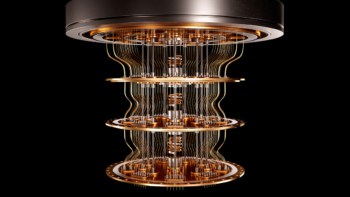
The last few years have seen rising interest in combining quantum computing and machine learning, with the hopes of discovering new capabilities and applications in both. Researchers at Aarhus University, Denmark and the University of Toronto, Canada, have now done just that by using quantum bits (qubits) to build a so-called “artificial spiking neuron” – a building block of a neural network that tries to mimic the way information flows in the brain. The researchers also showed that this new system can be used to compare and classify highly entangled quantum states – a procedure with applications in future quantum computers and other quantum technologies.
Spiking neural networks (SNNs) are a way of processing information that takes more direct inspiration from biological neurons than is the case with artificial neural networks (ANNs). While ANNs are more prominent as a model in machine learning, they are only vaguely inspired by biology. SNNs, in contrast, attempt to capture the time- and space-dependent behaviour of biological neural networks, making them both more powerful and more difficult to “train” and implement than other machine learning models.
Unlike in an ANN, the neurons in a SNN don’t transmit information at every cycle. Instead, they wait for an input signal to build up to a threshold value before sending out a “spike” signal. This spike then travels along the network, altering the signal values of other neurons and thus propagating information. While the information in SNNs is binary (spike or no spike), these networks capture real-time data like a brain would and process bits of information locally, since a single neuron is only connected to nearby, neighbouring neurons.
Neurons made of qubits
Quantum information is often processed using so-called “quantum gates” that change the qubits’ state in discrete steps. To build their artificial spiking quantum neuron, however, the Aarhus and Toronto researchers instead chose to approach information processing by making their qubits evolve continuously in time according to some controlled, time- and space-dependent parameters. This is closer to the way an SNN behaves because the state of the qubit is both time- and space-dependent, changing continuously in a way that depends on the states of the qubits that are nearby.

Neuron-inspired electrical model goes quantum
The researchers went on to show that such artificial spiking quantum neurons can be used to compare and classify the simplest two-qubit states that have maximum entanglement (known as Bell states). One neuron made up of three qubits, for example, can take an entangled state as an input and produce an output qubit that indicates the number of “excited” qubits it received as inputs, while a second neuron can indicate what phase the entangled state is in. Together, these two properties are enough to classify all four possible Bell state inputs. A simple neural network made up of a few such neurons can therefore take two Bell states as input and indicate whether they’re the same or not – an important step in several quantum computing protocols.
An open frontier
Given these results, which are described in Nature, the logical next step is to determine whether networks of this type can be scaled up. Making larger, more complex and more interesting quantum neural networks might hold the key to solving useful problems in the future, and Alán Aspuru-Guzik, a co-author on the paper, is optimistic about their potential. “When thinking about machine learning on quantum computers, it is still an open frontier,” he says. “Spiking quantum neural networks are a new framework that we hope inspires others to build upon.” He adds: “We are in an exciting era for quantum machine learning. Many models are constantly introduced. We are happy for our quantum spiking neurons as they represent a clear new direction for many of us to hack into the bush of unknown approaches.”



